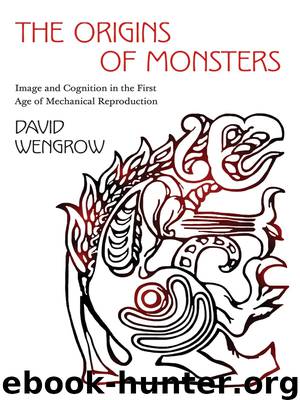The Origins of Monsters by Wengrow David

Author:Wengrow, David
Language: eng
Format: epub
Publisher: Princeton University Press
Published: 2013-05-02T16:00:00+00:00
TRANSFORMATIVE MODE: COMPOSITES INTRUDE
Transformative modes of image transfer belong to a wider class of what Andrew Bevan calls “contact phenomena,” appearing among communities that were being strongly influenced by external factors, “sometimes attractive, sometimes repellent.”2 Perhaps the most intensely investigated example is that of Iron Age Greece in a period of city-state formation, commercial expansion, and colonization.3 As Robin Osborne writes of Archaic Greek art:
The animals of the eighth century are predominantly domestic, those of the seventh century fantastic. Creatures of the imagination colonize pots and dedications alike. Not only do fantastic creatures appear in scenes that show stories, but all sorts of parts of vessels of clay, metal, wood, and stone turn into animals’ bodies. From the late eighth century molded snakes writhe their way around the shoulders of Athenian Late Geometric amphorae, and the tripod cauldrons, prestigious dedications at major sanctuaries, sprout griffins’ heads.4
What Osborne captures so effectively is the intrusion of composites—all of them imported from eastern sources—into the heart of an existing cultural milieu.5 The wider transformation of that milieu between the seventh and sixth centuries BC has been characterized as one in which architecture changed “from mud-brick huts with reed roofs and rough stone foundations into marble temples with precisely cut blocks and elegant decorative features, sculpture from small, lumpy terracotta figurines into over-life-size statues of marble or bronze, replete with observed detail, and painting from strips of purely linear design into large-scale figure-compositions of considerable refinement.’6
James Whitley provides a valuable discussion of local variability in the Greek reception of foreign composites, highlighting their wider social significance at a time of institutional change on the mainland.7 He focuses on the dispensation of orientalizing ceramics and metalwork in seventh-century Attica, identifying tensions in the consumption of eastern goods and imagery that were specific to that region, but also shed light on processes taking place in other parts of the Aegean. Throughout much of Greece, the seventh century BC was a period of heightened competition between local elites, whose authority was based on personal ties of loyalty, underpinned by kinship obligations and claims to ancestral status.8 Since the commencement of the Iron Age, in the tenth century, this aristocratic ideal had been sanctioned through a restricted set of ritual practices, in which the selective display of exotic trade items signaled the attainment of rank and status. Grave goods at that time show a hierarchical pattern of distribution in the archaeological record, and imagery—of chariots, battle scenes, and arrangements of human and animal figures—was carefully rationed on ceramics, metalwork, and ivories. With the exception of centaurs, which first appear on Late Geometric pottery, composites are absent from the decoration of these and other display media.
Whitley considers how, by the late eighth century—in Corinth, Euboea, and other parts of Greece—this established social order was disrupted and transformed through the arrival in increasing quantities of foreign trade goods and through the emergence of a cosmopolitan elite, membership of which was defined and signaled primarily through the use of non-Greek objects, images, and practices.
Download
This site does not store any files on its server. We only index and link to content provided by other sites. Please contact the content providers to delete copyright contents if any and email us, we'll remove relevant links or contents immediately.
Cecilia; Or, Memoirs of an Heiress — Volume 1 by Fanny Burney(32412)
Cecilia; Or, Memoirs of an Heiress — Volume 3 by Fanny Burney(31821)
Cecilia; Or, Memoirs of an Heiress — Volume 2 by Fanny Burney(31799)
The Great Music City by Andrea Baker(31248)
We're Going to Need More Wine by Gabrielle Union(18950)
All the Missing Girls by Megan Miranda(15488)
Pimp by Iceberg Slim(14316)
Bombshells: Glamour Girls of a Lifetime by Sullivan Steve(13949)
Talking to Strangers by Malcolm Gladwell(13184)
Norse Mythology by Gaiman Neil(13168)
Fifty Shades Freed by E L James(13144)
For the Love of Europe by Rick Steves(12629)
Mindhunter: Inside the FBI's Elite Serial Crime Unit by John E. Douglas & Mark Olshaker(9159)
Crazy Rich Asians by Kevin Kwan(9146)
The Lost Art of Listening by Michael P. Nichols(7385)
Enlightenment Now: The Case for Reason, Science, Humanism, and Progress by Steven Pinker(7160)
The Four Agreements by Don Miguel Ruiz(6596)
Bad Blood by John Carreyrou(6518)
Weapons of Math Destruction by Cathy O'Neil(6116)
